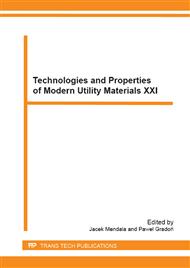p.133
p.137
p.141
p.145
p.151
p.157
p.163
p.167
p.175
Influence of Corrosion in "Acid Rain" on the Structure of Surface Layer of the ZnAl22Cu3 Alloy
Abstract:
The effect of corrosion in an "acid rain" (pH = 3.5) environment on the structure of the surface layer of the ZnAl22Cu3 alloy are presented in this study. Base alloy, alloy with silicon and alloy with silicon and rare earth elements were tested. The scope of the examination included potentiostatic tests in acid rain and studies of structure of surface layer of samples after corrosion tests. The studies have shown, that corrosion processes initially run quickly which leads to reduction of zinc in the surface layer and enriching in aluminum and copper so that the corrosion rate decreases. The presence of the silicon precipitates does not decrease the corrosion resistance of the ZnAl22Cu3 alloy in acid rain environment. The addition of rare earth elements improves the corrosion resistance of the ZnAl22Cu3 alloy in acid rain environment.
Info:
Periodical:
Pages:
151-156
Citation:
Online since:
December 2013
Authors:
Keywords:
Price:
Сopyright:
© 2014 Trans Tech Publications Ltd. All Rights Reserved
Share:
Citation:


